View in other NatureServe Network Field Guides
NatureServe
Montana
Utah
Wyoming
Idaho
Wisconsin
British Columbia
South Carolina
Yukon
California
New York
Leafy Spurge - Euphorbia virgata
Other Names:
Euphorbia esula [misapplied]
State Rank Reason (see State Rank above)
Euphorbia virgata is a plant native to Europe and Asia that was introduced into North America (FNA 2016). A conservation status rank is not applicable (SNA) because the plant is an exotic (non-native) in Montana that is not a suitable target for conservation activities.
NOTE: There is a discrepancy between the number of observations and counties represented in the herbaria (Consortium of Pacific Northwest Herbaria; www.pnwherbaria.org) versus the Montana Natural Heritage Program databases. It is important to document new County and other site occurrences with nice quality plant specimens of which some should be deposited in our State herbaria (University of Montana, Montana State University, Montana State University-Billings). Depositing specimens in the herbaria allows identifications to be confirmed, provides a central location for educating and sharing information, and allows specimens to be studied for genetics, morphology, and ecology.
General Description
PLANTS: Glabrous, perennial forb with spreading roots and branched stems that are 30–80 cm tall. Plants produce vegetative and flowering stems that when cut exude a white, milky latex. Stems are pale green to blue-green. Sources: Jacobs 2007; Lesica et al. 2012
LEAVES: Stem leaves are alternately arranged and sessile or with very short petioles. Leaf blades are green to blue-green, linear-oblanceolate in shape, 2–6 cm long, and have entire (smooth) margins. When cut leaves cut exude a white, milky latex. Sources: Jacobs 2007; Lesica et al. 2012
INFLORESCENCE: A terminal umbel of yellow-green, ovate bracts containing inconspicuous flowers that lack petals and sepals. The bracts are 8-16 mm long. Above the bracts, the true flowers are green and occur within a cup-like involucre called a cyathium (plural is cyathia). Each cyathium contains one seed (female) flower, 3 (male) pollen flowers, are 2–3 mm long, and have 4 yellowish glands with a lunate appendage. Fruits are a capsule, about 4 mm long, lobed and nearly smooth. Sources: Jacobs 2007; Stein 2011; Lesica et al. 2012
Phenology
Flowering and fruiting in spring through fall (FNA 2016).
Diagnostic Characteristics
Leafy Spurge -
Euphorbia virgata, exotic and Noxious
* A rhizomatous perennial.
* Stems are blue-green to pale green.
* Stem leaves are alternate below the inflorescence. Leaf blades are linear, linear-oblanceolate, or linear-oblong, 6-15 times longer than wide, margins are (almost) parallel at the middle, leaf apex is acute, and leaf base is truncate to abruptly attenuate.
* Leaf margins smooth (entire).
David's Spurge -
Euphorbia davidii, invasive exotic
* Annual with a taproot; not rhizomatous.
* Stem leaves all opposite.
* Capsules and seeds are larger. Seeds are essential for identification.
* Leaves are more elliptic and thicker with toothed margins.
* Hairs are shorter and stiffer.
Yellow Toadflax -
Linaria vulgaris, exotic and Noxious.
* Non-flowering plants are similar. Leaves are glabrous, long, and narrow.
* Flowers are snapdragon-like, yellow, and lack leafy bracts.
TAXONOMY & NOMENCLATURELeafy Spurge is part of a taxonomically complex group of species native to Europe and Asia (Berry et al.
in Flora of North America (FNA) 2016).
The
true Euphorbia esula Linnaeus is restricted to certain parts of Europe where it shows little tendency to weediness (Berry et al.
in FNA 2016). It is distinguished from
Euphorbia virgata Waldstein & Kitaibel by leaf shape.
Euphorbia esula Linnaeus has leaves that are oblanceolate to obovate-elliptic in shape, margins that are not parallel at the mid-leaf, an apex that is rounded to subacute, a base that is gradually attenuate to cuneate, and general size that is 3-8(-10) times longer than wide (Berry et al.
in FNA 2016). Herbarium specimens of
Euphorbia esula Linnaeus indicate plants were present in North America, but apparently have not persisted, and are assumed absent (Berry et al.
in FNA 2016).
Euphorbia virgata Waldstein & Kitaibel is widespread across Europe and temperate Asia, where it shows the same weedy characteristics found in North America (Berry et al.
in FNA 2016).
Euphorbia virgata Waldstein & Kitaibel retains the common name of "
Leafy Spurge" (Berry et al.
in FNA 2016).
Species Range
Montana Range
Range Descriptions
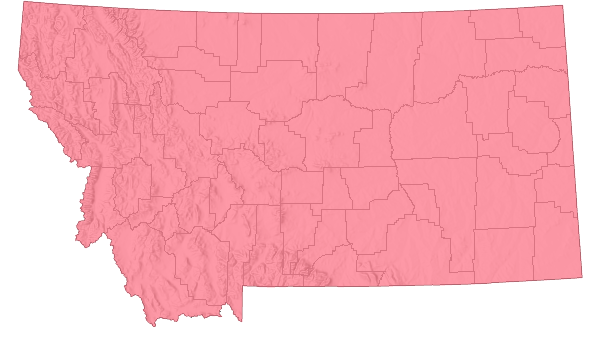
 Non-native
Non-native
Range Comments
Leafy Spurge [Euphoria virgata Waldstein & Kitaibel] is native to Europe and Asia. It may have been introduced into North America via Minnesota with shiploads of oats (Batho 1932). It may also have been brought to northeastern North America as an ornamental in 1829, where it escaped yards and gardens, and by the 1900s had spread to the west coast (Best et al. 1980). However, it is speculated that its weedy trait is caused by both hybridization and polyploidy (Berry et al. in FNA 2016). It is also possible that the widespread occurrence of Leafy Spurge in North America is partially a result of numerous introductions of grain imported from Eurasia (Berry et al. in FNA 2016).
Herbarium specimens of the true Euphorbia esula Linnaeus indicate that plants were present in the late 1800s to early 1900s in certain states within North America. However, there is no evidence that these introductions have persisted, and are assumed to be absent (Berry et al. in FNA 2016).
Adhikari et al. (2020) modeled the predicted future distribution of this and other weed species across the major road network in Montana under predicted future climate scenarios and found that area of predicted future habitat suitability is likely to increase.
For maps and other distributional information on non-native species see:
Nonindigenous Aquatic Species Database from the U.S. Geological Survey
Invasive Species Habitat Tool (INHABIT) from the U.S. Geological Survey
Invasive Species Compendium from the Centre for Agriculture and Bioscience International (CABI)
EDDMapS Species Information EDDMapS Species Information
Observations in Montana Natural Heritage Program Database
Number of Observations: 67231
(Click on the following maps and charts to see full sized version)
Map Help and Descriptions
Relative Density
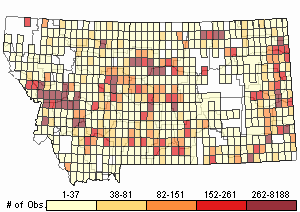
Recency
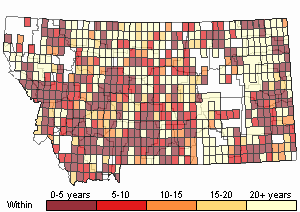
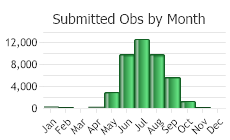
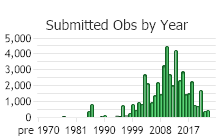
 (Observations spanning multiple months or years are excluded from time charts)
(Observations spanning multiple months or years are excluded from time charts)
Habitat
Grasslands, meadows, woodlands, and riparian forests in the plains and valleys of Montana (Lesica et al. 2012).
Ecology
Presumably due to it high genetic variability it easily adapts to local growing conditions. It is often found in pastures, rangelands, roadsides, waste areas, abandoned fields, and bottomlands. It is less frequent on upper slopes, summits, and shoulder slopes.
Leafy Spurge can avoid direct competition with other plants by growing at the very early and late portions of the growing season. Its deep and extensive root system makes it a strong competitor.
Reproductive Characteristics
Plants reproduce by seed and by adventitious buds on the root crown and on the spreading rootstock.
LIFE CYCLE [Adapted from Lajeunesse et al. in Sheley and Petroff 1999; Jacobs 2007.]
Shoots that grow from adventitious buds on the roots often emerge in April. Seeds typically germinate in the spring with peak emergence occurring from May to early June. Shortly after emergence seedlings grow roots with vegetative buds. If injured the buds break their dormancy to re-generate new shoots. Plants develop a root crown and produce both vegetative and flowering stems.
Plants that flower are usually two years old. In May to early June plants develop bracts, followed about 2 weeks later (mid-June) by flowers. It is the appearance of bracts that gives an appearance of blooming. By mid-July flowering is done. About 20-30 days later capsules have matured. Upon drying, capsules burst open to disperse the many seeds. This action can disperse seeds up to 15 feet. Each capsule produces 1-3 seeds.
Plants can also separate from its roots which breaks bud dormancy and stimulates shoot development. In later summer as soil moisture declines, the stems dry, appearing as light-brown to tan canes, and can become dormant. In the fall growth can resume. Plants are killed by a hard frost.
It is estimated that a plant can produce 30 to 130 seeds. Seeds buried 2 to 4 inches below the surface can germinate. In the soil seeds have been shown to retain viability for at least 8 years. Typically seeds germinate within two years after maturing. Seed dormancy is easily broken and germination can occur in a wide range of temperatures.
Seeds are dispersed by many methods: mechanical action of the drying capsule; floating in water; in mud that adheres to boots, vehicles and other equipment, animal hooves; cling to animal hair or clothing; through ingested and deposition in feces; and a contaminant in seed and haying.
FLOWERS
In the Cited Literature section consult Stein 2011 to learn about Euphorbia 'flowers', cyanthia.
ROOTS [Adapted from Lajeunesse et al. in Sheley and Petroff 1999; Jacobs 2007.]
Vertical roots can grow to 10 feet deep. Lateral roots can extend outwards from the parent plant by 15 feet per year. Roots are covered with thick, corky bark which allows them to better withstand drought, grazing pressures, or herbicide application. The roots sometimes exude translocated herbicides into the soil. The extensive root system can store large reserves of carbohydrates, which helps the plant sustain itself for years and be able to provide energy for re-growth. The extensive root system grows rapidly and extensively, making the plant difficult to manage (Lajeunesse et al. in Sheley and Petroff 1999). In 4 months and in the absence of competition, seedling roots grow to 3 feet deep and spread to 40 inches.
Management
See
Noxious Weed Education VideoAn integrated vegetative management approach provides the best long-term control for Leafy Spurge. It requires that land-use objectives and a desired plant community be identified (Shelly et al.
in Sheley and Petroff 1999). Once identified the integrated weed management strategy can promote a weed-resistant plant community that serves other land-use objectives such as livestock forage, wildlife habitat, or recreation (Shelly et al.
in Sheley and Petroff1999).
PREVENTION [Adapted from Lajeunesse et al.
in Sheley and Petroff 1999]
Preventing the establishment of Leafy Spurge can be accomplished by many practices:
* Learn how to accurately identify Leafy Spurge in order to detect occurrences and know where to implement control methods.
* Prevent vehicles from driving through and animals from grazing within infested areas.
* Thoroughly wash the undercarriage of vehicles and wheels in a designated area before moving to uninfested areas.
* Frequently monitor for new plants, and when found implement effective control methods.
* Maintain proper grazing management that creates resilience to noxious weed invasion.
* Use certified weed-free seeds and hay, including feed for pack animals.
* Before moving animals from infested areas, hold cattle for 6 days and sheep for 11 days in corrals or pastures to allow seed to pass through the digestive tract before moving to uninfested areas. Monitor and treat the holding area for emerging Leafy Spurge.
* Do not pick the flowers or transport plants. Where possible, contribute to or develop educational campaigns to help eradicate or reduce Leafy Spurge populations.
PHYSICAL and CULTURAL CONTROLS [Adapted from Lajeunesse et al.
in Sheley and Petroff 1999]
Hand-pulling can be done for small infestations. However, it is considered ineffective because of the deep depth of the root system and its numerous buds.
Mowing may remove flowering stems, but is ineffective for controlling Leafy Spurge because it re-sprouts from buds on the spreading roots.
Tilling can be effective if done intensively throughout the growing season or only during fall. The intensive program would begin in the spring, use a duckfoot cultivator that tills 4 inches deep, and repeats the tilling every 3 weeks until the soil freezes for 1 to 2 growing season. The schedule must not be interrupted because fragmented rootstock will quickly re-sprout. Machinery must be thoroughly cleaned to prevent contaminated the field and other areas. Fall-only cultivation would occur in the autumn when Leafy Spurge is 3-6 inches tall, cultivate 1-2 times after harvest, and for 3 years. Fall-only cultivation allows crops to grow, limits organic matter degradation, and reduces soil erosion. Combining the Fall-only cultivation with other methods could provide better control.
Prescribed burning by itself is ineffective for controlling Leafy Spurge because fire stimulates seed germination and re-sprouting of the buds on the root crown and spreading roots. However, herbicide absorption might be improved when integrated with a burning plan. Burning removes all of the above-ground biomass and provides a uniform surface for re-growth to be seen and for the herbicide to be applied uniformly. After burning about 5 weeks of re-growth should occur before the herbicide is applied. The combination does not control Leafy Spurge any better, but provides a better surface for herbicides to be applied and absorbed into the plant.
BIOLOGICAL CONTROLS [Adapted from Jacobs 2007]
14 insects have been approved for introduction into the U.S. as biological control for leafy spurge by the U.S. Department of Agriculture.
Of all the biocontrol insects for Leafy Spurge
Aphthona Flea Beetles are widespread and have reduced Leafy Spurge the most in Montana. The exception is
Minute Spurge Flea Beetle (
Aphthona abdominalis) which is reported as not established in Montana and not available in the U.S. The Leafy Spurge Flea Beetles are capable of surviving cold, sub-freezing winter temperatures. Larvae of
Aphthona Flea Beetles develop in the soil, and cool soil temperatures can delay development and establishment. Herbicide applications, grazing, or mowing that reduces the density of Leafy Spurge has been observed to improve flea beetle establishment. Ants are predators on these insects and releases should not occur where there are ant mounds.
Some bio-control companies sell or provide mixed releases to boost success since release sites vary in soil type, canopy cover, and moisture.
*
Brown Dot Leafy Spurge Flea Beetle (
Aphthona cyparissiae): Best where soils are 40 to 60 % sand and Leafy Spurge stems are taller than 21 inches and 50-121 stems per square yard based on research in Canada. Green Needle Grass (
Stipa viridula) is an indicator of suitable habitat in Canada.
*
Black Leafy Spurge Flea Beetle (
Aphthona czwalinae): It not does establish well in clay or acidic soils or in deeply shaded areas.
*
Copper Leafy Spurge Flea Beetle (
Aphthona flava)
*
Brown-legged Leafy Spurge Flea Beetle (
Aphthona lacertosa): Best where sites are open, sunny, mesic to moderately dry, but can do well on wet sites too.
*
Black Dot Leafy Spurge Flea Beetle (
Aphthona nigriscutis): Best suited for dry sites with full solar exposure, well-drained soils with less than 3% organic matter, and Leafy Spurge plants of less than 30 inches tall and fewer than 60 stems per square yard (Jacobs 2007). It has been found to feed on the native Euphorbia brachycera, which is a plant that occurs in Montana.
Clearwing Moth (
Chamaesphecia crassicornis): Moth where larvae attack roots and stems.
Hungarian Clearwing Moth (
Chamaesphecia hungarica): Moth where larvae attack roots.
Spurge Hawkmoth (
Hyles euphorbiae): Best where Leafy Spurge plants are dense within open areas near trees. Larvae consume leaves and can kill the plants. Larvae pass through five growth stages before becoming adults. Larvae have toxins that deter predators; however, their pupae are eaten by birds, ground squirrels, and other small mammals.
Red-headed Leafy Spurge Stem Borer (
Oberea erythrocephala): It seems to establish best in riparian areas and mesic sites with trees. When adults lay eggs they girdle and often kill Leafy Spurge stems. Larvae will kill stems when feeding, which reduces the plant’s ability to store energy or produce seeds. They are compatible with Apthona Flea Beetles, causing greater negative impacts to Leafy Spurge.
Leafy Spurge Tip Gall Midges (
Spurgia esulae): Best where sites are have cooler areas (partially shaded) with dense Leafy Spurge. The insect forms a gall at the tip of the stem. From the gall larvae attack the growing shoot tips, which prevents flowering but stimulates branching and shoot re-growth. The insect can produce up to three generations each summer which attack the new shoots.
Useful Links:Montana Invasive Species websiteMontana Biological Weed Control Coordination ProjectMontana Department of Agriculture - Noxious WeedsMontana Weed Control AssociationMontana Weed Control Association Contacts Webpage.
Montana Fish, Wildlife, and Parks - Noxious WeedsMontana State University Integrated Pest Management ExtensionWeed Publications at Montana State University Extension - MontGuidesStewardship Responsibility
Threats or Limiting Factors
Leafy spurge is very competitive, displacing native plants, and it can form monocultures (Lajeunesse et al. in Sheley and Petroff 1999). This causes a loss in plant diversity and a loss of forage and habitat for wildlife species (Lajeunesse et al. in Sheley and Petroff 1999).
Leafy spurge is a strong competitor because mature plants can sprout new stems from buds on the roots in April – before many other plants are growing (Lajeunesse et al. in Sheley and Petroff 1999). Plants may become dormant in late summer as soil moisture declines, but come fall plants can re-grow by take advantage of moisture, light, and nutrient resources (Lajeunesse et al. in Sheley and Petroff 1999).
References
- Literature Cited AboveLegend:
 View Online Publication
View Online Publication Adhikari, A., L.J. Rew, K.P. Mainali, S. Adhikari, and B.D. Maxwell. 2020. Future distribution of invasive weed species across the major road network in the state of Montana, USA. Regional Environmental Change 20(60):1-14. https://doi.org/10.1007/s10113-020-01647-0
Adhikari, A., L.J. Rew, K.P. Mainali, S. Adhikari, and B.D. Maxwell. 2020. Future distribution of invasive weed species across the major road network in the state of Montana, USA. Regional Environmental Change 20(60):1-14. https://doi.org/10.1007/s10113-020-01647-0 Lesica, P., M.T. Lavin, and P.F. Stickney. 2012. Manual of Montana Vascular Plants. Fort Worth, TX: BRIT Press. viii + 771 p.
Lesica, P., M.T. Lavin, and P.F. Stickney. 2012. Manual of Montana Vascular Plants. Fort Worth, TX: BRIT Press. viii + 771 p. Sheley, Roger, and Janet Petroff. 1999. Biology and Management of Noxious Rangeland Weeds. Oregon State University Press, Corvallis, Oregon.
Sheley, Roger, and Janet Petroff. 1999. Biology and Management of Noxious Rangeland Weeds. Oregon State University Press, Corvallis, Oregon.
- Additional ReferencesLegend:
 View Online Publication
View Online Publication
Do you know of a citation we're missing? Bakke, A.L. 1936. Leafy spurge, Euphorbia esula L. Iowa Agric. Exp. Stn. Res. Bull. 198:209-245.
Bakke, A.L. 1936. Leafy spurge, Euphorbia esula L. Iowa Agric. Exp. Stn. Res. Bull. 198:209-245. Bartz, S., B. Landgraf, P. Fay, and K. Havstad. 1984. Leafy spurge (Euphorbia esula) as a forage component for ewes and lambs. Montana Agr. Exp. Sta. Journal Paper No. J-1495.
Bartz, S., B. Landgraf, P. Fay, and K. Havstad. 1984. Leafy spurge (Euphorbia esula) as a forage component for ewes and lambs. Montana Agr. Exp. Sta. Journal Paper No. J-1495. Best, K.F., G.G. Bowes, A.G. Thomas, and M.G. Maw. 1980. The biology of Canadian weeds. 39. Euphorbia esula L. Can. J. Plant Science 60:651-663.
Best, K.F., G.G. Bowes, A.G. Thomas, and M.G. Maw. 1980. The biology of Canadian weeds. 39. Euphorbia esula L. Can. J. Plant Science 60:651-663. Boggs, K. W. 1984. Succession in riparian communities of the lower Yellowstone River, Montana. M.S. Thesis. Montana State University, Bozeman, 107 pp.
Boggs, K. W. 1984. Succession in riparian communities of the lower Yellowstone River, Montana. M.S. Thesis. Montana State University, Bozeman, 107 pp. Bowes, G.G., and A.G. Thomas. 1987. Longevity of leafy spurge seeds in the soil following various control programs. J. Range Management. 31:137-140.
Bowes, G.G., and A.G. Thomas. 1987. Longevity of leafy spurge seeds in the soil following various control programs. J. Range Management. 31:137-140. Calvin, M. 1978. Greenfactories. Chem. and Eng. News 56:30-36.
Calvin, M. 1978. Greenfactories. Chem. and Eng. News 56:30-36. Coupland, R.T., G.W. Selleck, and J.F. Alex. 1955. The reproductive capacity of vegetative buds on the underground parts of leafy spurge (Euphorbia esula L.) Can J. Agric. Sci. 35:477-484.
Coupland, R.T., G.W. Selleck, and J.F. Alex. 1955. The reproductive capacity of vegetative buds on the underground parts of leafy spurge (Euphorbia esula L.) Can J. Agric. Sci. 35:477-484. Dunn, P.H., and A. Radcliffe-Smith. 1980. The variability of leafy spurge (Euphorbia spp.) in the United States. North Central Weed Control Conf. Res. Rep., Vol. 37:48-53.
Dunn, P.H., and A. Radcliffe-Smith. 1980. The variability of leafy spurge (Euphorbia spp.) in the United States. North Central Weed Control Conf. Res. Rep., Vol. 37:48-53. Durham, R. A., D. L. Mummey, L. Shreading, and P.W. Ramsey. 2017. Phenological patterns differ between exotic and native plants: Field observations from the Sapphire Mountains, Montana. Natural Areas Journal, 37(3), 361–381.
Durham, R. A., D. L. Mummey, L. Shreading, and P.W. Ramsey. 2017. Phenological patterns differ between exotic and native plants: Field observations from the Sapphire Mountains, Montana. Natural Areas Journal, 37(3), 361–381. Eggers, M.J.S. 2005. Riparian vegetation of the Montana Yellowstone and cattle grazing impacts thereon. M.Sc. Thesis. Montana State University, Bozeman, MT. 125 p.
Eggers, M.J.S. 2005. Riparian vegetation of the Montana Yellowstone and cattle grazing impacts thereon. M.Sc. Thesis. Montana State University, Bozeman, MT. 125 p. Flora of North America Editorial Committee, eds. 2016. Flora of North America north of Mexico, Vol. 12. Magnoliophyta: Vitaceae to Garryaceae. Oxford University Press, Inc. New York.
Flora of North America Editorial Committee, eds. 2016. Flora of North America north of Mexico, Vol. 12. Magnoliophyta: Vitaceae to Garryaceae. Oxford University Press, Inc. New York. Fritzen, D.E. 1995. Ecology and behavior of Mule Deer on the Rosebud Coal Mine, Montana. Ph.D. Dissertation. Bozeman, MT: Montana State University. 143 p.
Fritzen, D.E. 1995. Ecology and behavior of Mule Deer on the Rosebud Coal Mine, Montana. Ph.D. Dissertation. Bozeman, MT: Montana State University. 143 p. Guenther, G.E. 1989. Ecological relationships of bitterbrush communities on the Mount Haggin Wildlife Management Area. M.Sc. Thesis. Bozeman, MT: Montana State University. 73 p.
Guenther, G.E. 1989. Ecological relationships of bitterbrush communities on the Mount Haggin Wildlife Management Area. M.Sc. Thesis. Bozeman, MT: Montana State University. 73 p. Hanson, H.C., and V.E. Rudd. 1933. Leafy spurge life history and habits. North Dakota Agric. Exp. Sta. Bull. 266. 24 pp.
Hanson, H.C., and V.E. Rudd. 1933. Leafy spurge life history and habits. North Dakota Agric. Exp. Sta. Bull. 266. 24 pp. Harris, P., P.H. Dunn, D. Schroeder, and R. Vonmoos. 1985. Biological control of leafy spurge in North America. Weed Sci. Sco. Amer. Monograph Series 3:79-92.
Harris, P., P.H. Dunn, D. Schroeder, and R. Vonmoos. 1985. Biological control of leafy spurge in North America. Weed Sci. Sco. Amer. Monograph Series 3:79-92. Johnson, J.D. 2004. Restoring native species to crested wheatgrass dominated rangelands. M.Sc.Thesis. Bozeman, MT: Montana State University. 58 p.
Johnson, J.D. 2004. Restoring native species to crested wheatgrass dominated rangelands. M.Sc.Thesis. Bozeman, MT: Montana State University. 58 p. Johnson, T. W. 1982. An analysis of pack and saddle stock grazing areas in the Bob Marshall Wilderness. M.Sc.Thesis. Bozeman, MT: Montana State University. 105 p.
Johnson, T. W. 1982. An analysis of pack and saddle stock grazing areas in the Bob Marshall Wilderness. M.Sc.Thesis. Bozeman, MT: Montana State University. 105 p. Lehnhoff, E.A., L.J.Rew, J.M. Mangold, T. Seipel, and D. Ragen.2019. Integrated management of Cheatgrass (Bromus tectorum) with sheep grazing and herbicide. Agronomy 9, 315
Lehnhoff, E.A., L.J.Rew, J.M. Mangold, T. Seipel, and D. Ragen.2019. Integrated management of Cheatgrass (Bromus tectorum) with sheep grazing and herbicide. Agronomy 9, 315 Lesica, P., M.T. Lavin, and P.F. Stickney. 2022. Manual of Montana Vascular Plants, Second Edition. Fort Worth, TX: BRIT Press. viii + 779 p.
Lesica, P., M.T. Lavin, and P.F. Stickney. 2022. Manual of Montana Vascular Plants, Second Edition. Fort Worth, TX: BRIT Press. viii + 779 p. Martinka, R.R. 1970. Structural characteristics and ecological relationships of male blue grouse (Dendragapus obscurus (Say)) territories in southwestern Montana. Ph.D Dissertation. Bozeman, MT: Montana State University. 73 p.
Martinka, R.R. 1970. Structural characteristics and ecological relationships of male blue grouse (Dendragapus obscurus (Say)) territories in southwestern Montana. Ph.D Dissertation. Bozeman, MT: Montana State University. 73 p. Matlock-Cooley, S.J. 1993. Interaction between Deermice, Antelope Bitterbrush, and cattle in southwest Montana. M.Sc. Thesis. Bozeman, MT: Montana State University 84 p.
Matlock-Cooley, S.J. 1993. Interaction between Deermice, Antelope Bitterbrush, and cattle in southwest Montana. M.Sc. Thesis. Bozeman, MT: Montana State University 84 p. Maxwell, B.D. 1984. Changes in an infested plant community after an application of picloram, the effect of glyphosate on bud dormancy, the effect of pulling and the fuel potential of leafy spurge (Euphorbia esula L.). M.Sc. Thesis. Bozeman, MT: Montana State University. 73 p.
Maxwell, B.D. 1984. Changes in an infested plant community after an application of picloram, the effect of glyphosate on bud dormancy, the effect of pulling and the fuel potential of leafy spurge (Euphorbia esula L.). M.Sc. Thesis. Bozeman, MT: Montana State University. 73 p. Nissen, S.J. 1986. Starch utilization, root bud correlative inhibition, and endogenous indole-3-acetic acid levels in leafy spurge (Euphorbia esula L.) Ph.D. Dissertation. Bozeman, MT: Montana State University. 46 p.
Nissen, S.J. 1986. Starch utilization, root bud correlative inhibition, and endogenous indole-3-acetic acid levels in leafy spurge (Euphorbia esula L.) Ph.D. Dissertation. Bozeman, MT: Montana State University. 46 p. Noble, D.L. 1980. Evidence of leafy spurge dispersal by birds. Weed Sci. Soc. Am. Newsletter 8(3):8.
Noble, D.L. 1980. Evidence of leafy spurge dispersal by birds. Weed Sci. Soc. Am. Newsletter 8(3):8. Olliff, Tom, Roy Renkin, Craig McClure, Paul Miller, Dave Price, Dan Reinhart, and Jennifer Whipple. 2001. Managing A Complex Exotic Vegetation Program in Yellowstone National Park.
Olliff, Tom, Roy Renkin, Craig McClure, Paul Miller, Dave Price, Dan Reinhart, and Jennifer Whipple. 2001. Managing A Complex Exotic Vegetation Program in Yellowstone National Park. Quire, R.L. 2013. The sagebrush steppe of Montana and southeastern Idaho shows evidence of high native plant diversity, stability, and resistance to the detrimental effects of nonnative plant species. M.Sc. Thesis. Bozeman, MT: Montana State University. 124 p.
Quire, R.L. 2013. The sagebrush steppe of Montana and southeastern Idaho shows evidence of high native plant diversity, stability, and resistance to the detrimental effects of nonnative plant species. M.Sc. Thesis. Bozeman, MT: Montana State University. 124 p. Raju, M.V.S. 1975. Experimental studies on leafy spurge (Euphorbia esula L.) I. Ontogeny and distribution of buds and shoots on the hypocotyl. Bot. Gaz. 136:254-261.
Raju, M.V.S. 1975. Experimental studies on leafy spurge (Euphorbia esula L.) I. Ontogeny and distribution of buds and shoots on the hypocotyl. Bot. Gaz. 136:254-261. Rens, E.N. 2003. Geographical analysis of the distribution and spread of invasive plants in the Gardiner Basin, MT. M.Sc. Thesis. Bozeman, MT: Montana State University. 100 p.
Rens, E.N. 2003. Geographical analysis of the distribution and spread of invasive plants in the Gardiner Basin, MT. M.Sc. Thesis. Bozeman, MT: Montana State University. 100 p. Rinella, M.J., A.D. Knudsen, J.S. Jacobs, and J.M. Mangold. 2020. Seeding causes long-term increases in grass forage production in invaded rangelands. Rangeland and Ecology Management 73(2020): 329-333.
Rinella, M.J., A.D. Knudsen, J.S. Jacobs, and J.M. Mangold. 2020. Seeding causes long-term increases in grass forage production in invaded rangelands. Rangeland and Ecology Management 73(2020): 329-333. Seipel, T.F. 2006. Plant species diversity in the sagebrush steppe of Montana. M.Sc. Thesis. Bozeman, MT: Montana State University. 87 p.
Seipel, T.F. 2006. Plant species diversity in the sagebrush steppe of Montana. M.Sc. Thesis. Bozeman, MT: Montana State University. 87 p. Selleck, G.W. 1958. Life history of leafy spurge. Proc. N.C. Weed. Cont. Conf. Pp. 16-17.
Selleck, G.W. 1958. Life history of leafy spurge. Proc. N.C. Weed. Cont. Conf. Pp. 16-17. Selleck, G.W., R.T. Coupland, and C. Frankton. 1962. Leafy spurge in Saskatchewan. Ecolog. Monogr. 32:1-29.
Selleck, G.W., R.T. Coupland, and C. Frankton. 1962. Leafy spurge in Saskatchewan. Ecolog. Monogr. 32:1-29. Steenhagen, D.A., and R.L. Zomdahl. 1979. Allelopathy of leafy spurge. Weed Sci. 27:1-3.
Steenhagen, D.A., and R.L. Zomdahl. 1979. Allelopathy of leafy spurge. Weed Sci. 27:1-3. Stein, G. 2011. Euphorbia 'flowers', an introduction to the amazing Cyathia. https://davesgarden.com/guides/articles/view/3208
Stein, G. 2011. Euphorbia 'flowers', an introduction to the amazing Cyathia. https://davesgarden.com/guides/articles/view/3208 Wiman, N.G. 2001. Dynamics of leafy spurge (Euphorbia esula L.) infested plant communities influenced by flea beetles in the Aphthona complex (Colepotera: Chrysomelidae). M.Sc. Thesis. Bozeman, MT: Montana State University. 148 p.
Wiman, N.G. 2001. Dynamics of leafy spurge (Euphorbia esula L.) infested plant communities influenced by flea beetles in the Aphthona complex (Colepotera: Chrysomelidae). M.Sc. Thesis. Bozeman, MT: Montana State University. 148 p.
- Web Search Engines for Articles on "Leafy Spurge"





